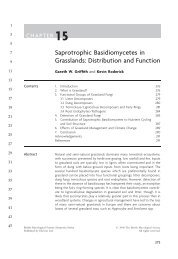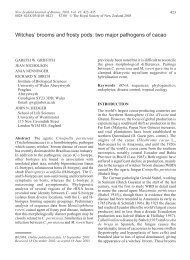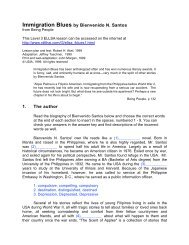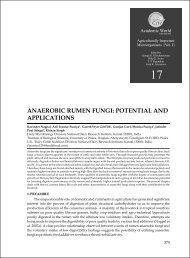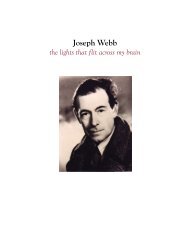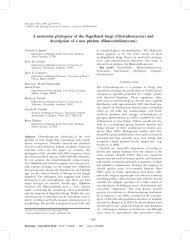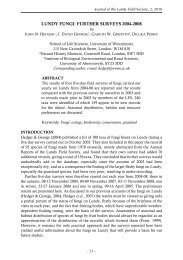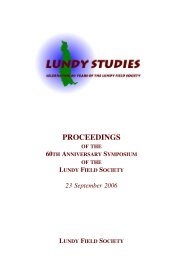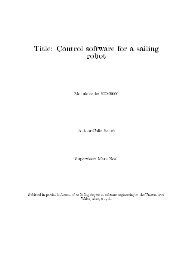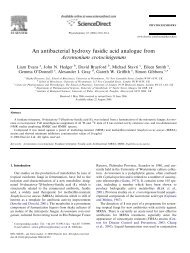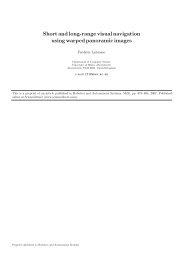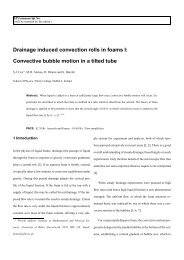Download the pdf - Users Site
Download the pdf - Users Site
Download the pdf - Users Site
Create successful ePaper yourself
Turn your PDF publications into a flip-book with our unique Google optimized e-Paper software.
Ectomycorrhizas with macrofungi (ascomycetes and basidiomycetes). These are<br />
sometimes specific to tree species, and are signalled by <strong>the</strong> presence of fruit bodies<br />
of <strong>the</strong> partner fungi under <strong>the</strong> tree in <strong>the</strong> autumn. These are produced by a mycelium<br />
which ramifies through <strong>the</strong> soil and litter, but which also envelopes part of <strong>the</strong> root<br />
system in a mycelial sheath, through which nutrient exchange takes place, <strong>the</strong>reby<br />
assisting <strong>the</strong> host tree.<br />
A third functional grouping is <strong>the</strong> pathogenic fungi which invade living plants<br />
and trees on Lundy. The effects of <strong>the</strong>se pathogens range from killing parts of <strong>the</strong><br />
plant, to almost symptomless infections. Fungi which invade <strong>the</strong> plant and kill <strong>the</strong><br />
tissue are often called ‘necrotrophs’ (lit. ‘feeding off death’) and <strong>the</strong>ir presence on<br />
plants is shown by brown areas of dead tissue on leaves and stems. The effects are<br />
often only local - for example, just a few brown spots on <strong>the</strong> leaves. On Lundy most<br />
of <strong>the</strong>se necrotrophs are microfungi, some of which are specific to particular plant<br />
species, o<strong>the</strong>rs have a wide host range. In contrast <strong>the</strong> fungal pathogens called<br />
‘biotrophs’(lit. ‘feeding off life’) infect <strong>the</strong> host with few or no symptoms. Infected<br />
plants may appear completely healthy, although <strong>the</strong>re is sometimes some<br />
malformation of tissues. The production of spores by <strong>the</strong> fungus, for example in<br />
pustules on a leaf surface, may be <strong>the</strong> only sign that <strong>the</strong> plant is infected. These<br />
fungi have a very narrow host range, sometimes just one plant species. All are<br />
microfungi and on Lundy include <strong>the</strong> rusts (Uredinales), <strong>the</strong> smuts (Ustilaginales),<br />
<strong>the</strong> powdery mildews (Erysiphales) and <strong>the</strong> downy mildews (Peronosporales).<br />
WOODLAND HABITATS FOR FUNGI ON LUNDY<br />
The past land-use on Lundy, as with o<strong>the</strong>r small islands, has had a disproportionate<br />
influence on <strong>the</strong> vegetation and its associated fungi compared to <strong>the</strong> mainland.<br />
Clearance of such postglacial forest cover as existed on Lundy probably began in <strong>the</strong><br />
Bronze Age and Hubbard (1971) considers that cutting of trees for construction and<br />
firewood by islanders and visiting ships, combined with <strong>the</strong> exposure, meant that <strong>the</strong><br />
island was almost completely treeless as far back as <strong>the</strong> thirteenth century, although<br />
she cites evidence that scrub, such as gorse, willow and blackthorn, must have<br />
persisted. Large scale replanting of trees only began in <strong>the</strong> nineteenth century, many<br />
of <strong>the</strong>m exotic species such as turkey oak, holm oak and Corsican pine, possibly<br />
accompanied by associated fungal species. The surviving tree cover is now restricted<br />
to <strong>the</strong> S.E. end of <strong>the</strong> island, especially <strong>the</strong> Millcombe Valley area (South Wood,<br />
North Wood, St John’s Copse and Lower Millcombe), <strong>the</strong> small pockets of planted<br />
alders, sycamores, pines and oaks fur<strong>the</strong>r up <strong>the</strong> east coast, including St Helen’s<br />
Copse and Quarter Wall Copse, and <strong>the</strong> few scattered willows around <strong>the</strong> Quarry.<br />
As well as such ‘true’ woodland, <strong>the</strong> extensive gorse/blackthorn scrub behind<br />
Brambles Cottage and around <strong>the</strong> Flagstaff and <strong>the</strong> Ugly, as well as <strong>the</strong><br />
rhododendron along <strong>the</strong> east coast path, also represent a type of woodland habitat<br />
(Dawkins 1974 in Hubbard 1997).<br />
It has been estimated that about 80% of <strong>the</strong> macrofungi of <strong>the</strong> Ne<strong>the</strong>rlands are<br />
associated with trees (Arnolds & De Vries 1989 in Griffith et al., 2004), and <strong>the</strong><br />
U.K. figure is probably similar. Most of <strong>the</strong> decomposer and mycorrhizal fungi<br />
- 142 -



